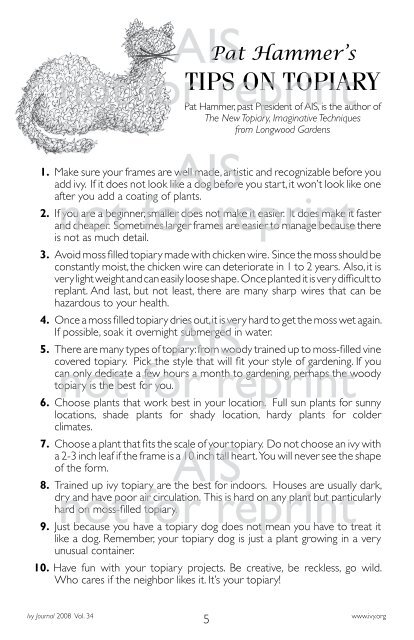AIS not for reprint AIS not for reprint AIS not for reprint AIS not for ...
AIS not for reprint AIS not for reprint AIS not for reprint AIS not for ...
AIS not for reprint AIS not for reprint AIS not for reprint AIS not for ...
You also want an ePaper? Increase the reach of your titles
YUMPU automatically turns print PDFs into web optimized ePapers that Google loves.
<strong>AIS</strong> Pat Hammer’s<br />
<strong>not</strong> <strong>for</strong><br />
Tips<br />
<strong>reprint</strong><br />
on Topiary<br />
Pat Hammer, past President of <strong>AIS</strong>, is the author of<br />
The New Topiary, Imaginative Techniques<br />
from Longwood Gardens<br />
<strong>AIS</strong><br />
1. Make sure your frames are well made, artistic and recognizable be<strong>for</strong>e you<br />
add ivy. If it does <strong>not</strong> look like a dog be<strong>for</strong>e you start, it won’t look like one<br />
after<br />
<strong>not</strong><br />
you add a coating<br />
<strong>for</strong><br />
of plants.<br />
<strong>reprint</strong><br />
2. If you are a beginner, smaller does <strong>not</strong> make it easier. It does make it faster<br />
and cheaper. Sometimes larger frames are easier to manage because there<br />
is <strong>not</strong> as much detail.<br />
3. Avoid moss filled topiary made with chicken wire. Since the moss should be<br />
constantly moist, the chicken wire can deteriorate in 1 to 2 years. Also, it is<br />
very light weight and can easily loose shape. Once planted it is very difficult to<br />
replant. And last, but <strong>not</strong> least, there are many sharp wires that can be<br />
hazardous to your health.<br />
4. Once a moss filled topiary dries<br />
<strong>AIS</strong><br />
out, it is very hard to get the moss wet again.<br />
If possible, soak it overnight submerged in water.<br />
5. There are many types of topiary: from woody trained up to moss-filled vine<br />
covered<br />
<strong>not</strong><br />
topiary. Pick<br />
<strong>for</strong><br />
the style that<br />
<strong>reprint</strong><br />
will fit your style of gardening. If you<br />
can only dedicate a few hours a month to gardening, perhaps the woody<br />
topiary is the best you.<br />
6. Choose plants that work best in your location. Full sun plants <strong>for</strong> sunny<br />
locations, shade plants <strong>for</strong> shady location, hardy plants <strong>for</strong> colder<br />
climates.<br />
7. Choose a plant that fits the<br />
<strong>AIS</strong><br />
scale of your topiary. Do <strong>not</strong> choose an ivy with<br />
a 2-3 inch leaf if the frame is a 10 inch tall heart. You will never see the shape<br />
of the <strong>for</strong>m.<br />
8. Trained<br />
<strong>not</strong><br />
up ivy topiary<br />
<strong>for</strong><br />
are the best <strong>for</strong><br />
<strong>reprint</strong><br />
indoors. Houses are usually dark,<br />
dry and have poor air circulation. This is hard on any plant but particularly<br />
hard on moss-filled topiary.<br />
9. Just because you have a topiary dog does <strong>not</strong> mean you have to treat it<br />
like a dog. Remember, your topiary dog is just a plant growing in a very<br />
unusual container.<br />
10. Have fun with your topiary projects. Be creative, be reckless, go wild.<br />
Who cares if the neighbor likes it. It’s your topiary!<br />
Ivy Journal 2008 Vol. 34<br />
5<br />
www.ivy.org





